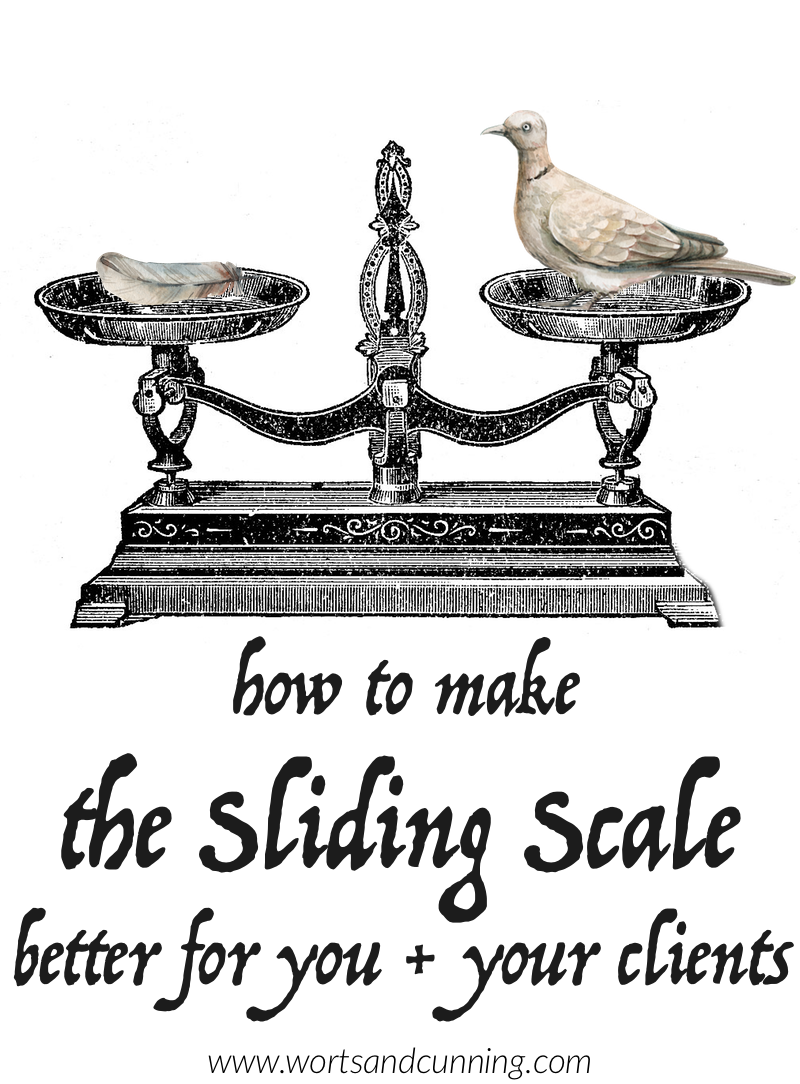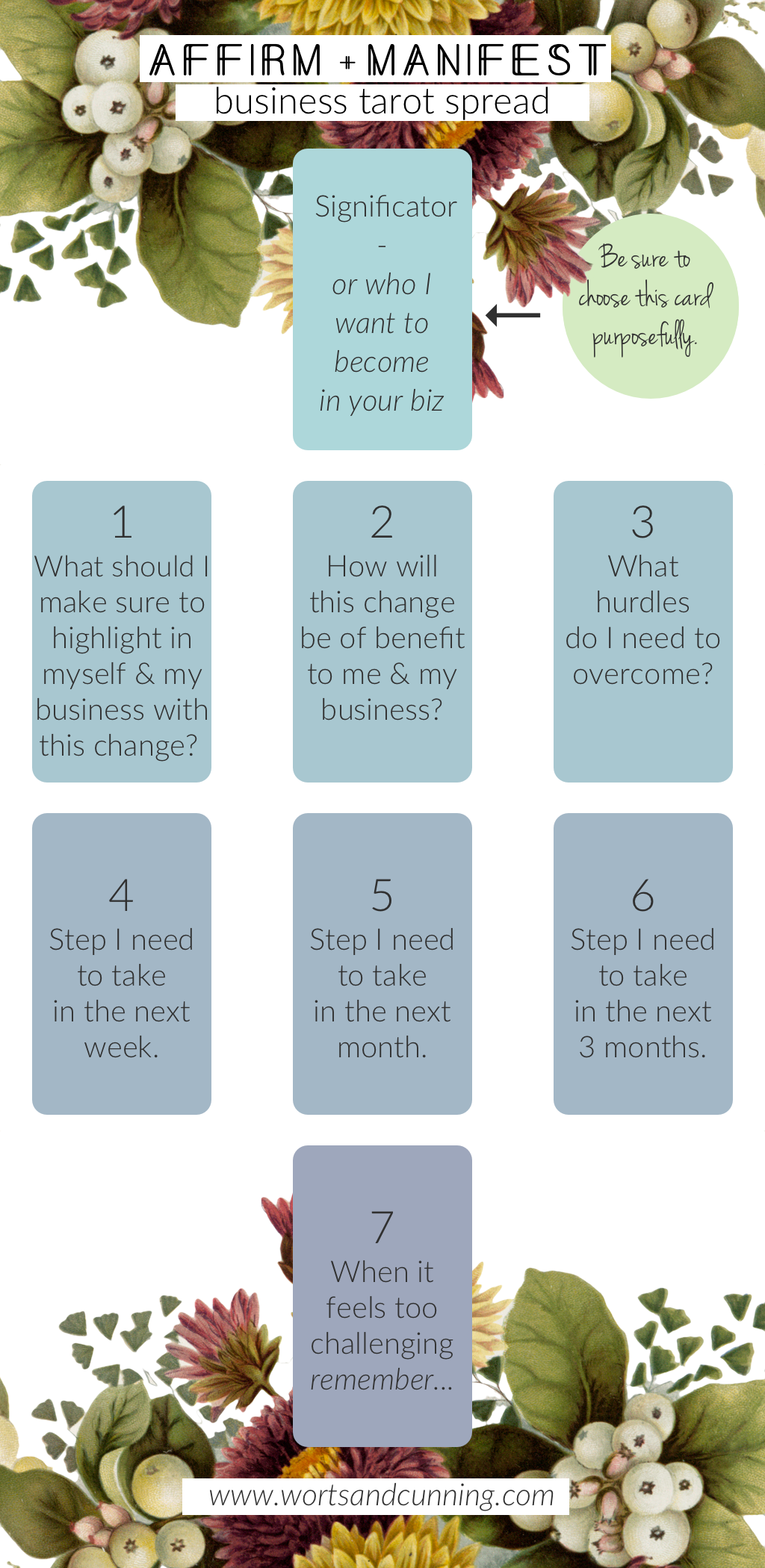How to Make the Sliding Scale Better for You + Your Clients
It’s been a few years since I wrote about the sliding scale and it’s time to write that long awaited follow-up post that’s been percolating in the back of my mind. I’ve also written about ways that I focus on creating access and not scarcity in my marketing.
What my sliding scale looks like now as opposed to when I started my business is very different. I’ve grown, I’ve examined (and continue to examine) my own hang-ups around money and fears about financial stability alongside being a good activist, and what follows is hopefully some useful insight. There still isn’t a lot of resources about the sliding scale or using alternative payment methods for services and goods out there. If you have some favorites, please let me know in the comments. If you’ve found what I’ve written to be useful please feel free to use the language from this post with credit on your own page and resources. I’ve made some really amazing connections with folks through these posts and I would love to continue on the conversation through continued resource sharing.
So let’s get into it!
The disadvantages of the sliding scale.
The biggest disadvantage of the sliding scale is that folks will take advantage of it.
Most of the time it’s not entirely on purpose - in the US we have very little education in our school system and culture around money, class, service value, and fair wages. Class is a big one and folks are not only unaware of what class they belong to currently (as opposed to when they were kids or the class that their parents belong to but not them) but of any class privilege they carry. When the scale has been used incorrectly it’s often by folks who have more than enough money to pay full price yet they have purchased at the lower end of my sliding scale. As opposed to my students and clients who have far less money who typically pay the full class price or a higher percentage of their income than their financially better off peer. It’s a frustrating dynamic and it’s a whole other post about why that happens, but if you’ve been offering the sliding scale for any length of time you’ve probably experienced this.
I want to take a moment here to say that it’s ok to feel frustrated when someone takes advantage of your sliding scale. Feel your frustration, make adjustments as needed (suggestions are below) but also realize you have to also accept this as part of the risk of a sliding scale offering. If it feels more emotionally draining to offer a sliding scale - don’t do it. That’s really ok. The purpose of creating accessibility in our offerings is not to create unneeded stress or complication in our lives but, instead, to help everyone involved in the transaction feel more empowered.
Not getting paid fairly.
Other disadvantages of the sliding scale include not getting paid enough for your time because you’ve set your scale too low - but this can be adjusted to make sure that this doesn’t happen (again, details below). Usually this takes a bit of trial and error that can feel stressful if you’re pulling in way less money than you should in the meantime.
It stresses people out.
Finally, the sliding scale can really stress out some people when they go to use it. While this isn’t entirely your responsibility to manage you can make the sliding scale feel less scary and intimidating to people who don’t want to “mess it up” when figuring what price they should pay. I’ve definitely stressed out about using the sliding scale as a consumer before which is why I feel invested in helping my community not feel that way - so I share what makes it easier for me and my clients below.
What I have found to be really useful versus what I don’t do anymore.
I offer a managed sliding scale.
I no longer offer a completely open sliding scale (i.e. a sliding scale of $0 - $100 that folks can choose any amount from). What this means is that for any one of my classes or one-on-one offerings there is a limited amount of tickets at each price along the sliding scale. I typically offer about three different ticket prices for a class, though for some classes I offer a broader range and others I offer only two price differences. So when you go to purchase a class ticket from me you’ll see something like the following:
Tickets : The Plant Sabbat is offered at a sliding scale. The actual cost of the class is $35 and tickets listed below that price are limited. Please read my sliding scale guide below before purchasing a ticket.
3 tickets are available at $20
5 tickets are available at $30
Unlimited tickets are available at $35
I calculate the ticket prices offered and the amount of tickets in each bracket available based on my hourly wage that I’ve set for myself as a teacher, space rental or online hosting fees, supplies and materials, and any additional costs that may arise (such as the research that goes in before and after I meet with someone for a herbal consult). Setting up a managed sliding scale like this does a number of things:
It helps make sure that I get paid fairly.
It’s transparent which helps folks make decisions more mindfully. Folks are less likely to just choose the bottom option if they see that there are limits.
Overall, I’ve found this to be a much more sustainable way of offering different price levels for class or service than what I had been doing before. I have a bit more control and I usually end up being paid fairly. The whole process feels way less stressful than it used to.
EDIT: I now offer a pay-it-forward price that is a few dollars above the actual cost of the class. I let folks know that if they purchase a class ticket at this price that they are supporting financial accessibility for those folks lower down on the scale. I’ve gotten a great response to it and folks really like being able to join my class while easily contributing to my ability to make that class open and accessible to more and more folks.
The other essential component to a managed sliding scale system is to explain it to your clients as simply as possible. I tend to be wordy in my writing so this has been an ongoing work in progress. As you can see in my description above I tell folks to take a look at my sliding scale guide which can be found as part of the course or offering description and reads as follows:
A Quick Guide to the Sliding Scale
While I encourage you to read my full thoughts on the sliding scale, here is a very brief rundown:
The top price class ticket is the actual cost of the class. If you choose a ticket price below the top tier you are receiving a discount.
The middle price is for those who are able to meet their basic needs but have little-to-no expendable income. Paying for this class may qualify as a sacrifice but it would not create hardship.
The bottom price is for those who struggle to meet basic needs and paying for this class would still be a significant hardship.
The Pay-It-Forward price is a few bucks above the actual cost of the class and that extra money goes towards supporting scholarships as well as future free and low-cost classes. Essentially it's an opportunity to not only take your class but also support your fellow community members while you're at it. Sweet!
Since creating this shorthand guide, a limited amount of tickets in each bracket, along with setting up a culture of openness around money in my classes (more on that below), I’ve found folks using the sliding scale accurately and in a way that feels empowering. Establishing and sharing the actual price of the class has been key as well as distinguishing between something that is a financial sacrifice versus a hardship (which I go into more depth here).
I’ve set up a culture in my classes where money is not scary but fun to talk about.
Talking about money is awkward especially if you’re collecting money at the door as opposed to online sales. I try to be as clear about expectations as possible by stating when, where, and how class money will be collected (for example, sometimes for donation based classes I collect at the end of class) so that folks aren’t stressing about what to do around payment. I let folks know the range of prices and the actual cost of the course (all of which has been posted on my website ahead of time). I establish a “lucky” mug or teapot as the receptacle of abundance for collecting money; I look folks in the eyes and thank them genuinely for whatever they’re able to give (which can be hard sometimes when you know someone is underpaying you, let’s be honest. But it’s also a practice in compassion and gratefulness that you choose to take on when offering the sliding scale or hosting donation-based events). With my magickal crowds we even say a little spell between us for abundance - because that’s how my Witch kin are like and I love it.
Making money fun to talk about is always a work in progress and I’m learning as I go along - let me know how you make money an easy thing to talk about in the comments below. I would love more ideas and inspiration!
I don’t discount my services.
I’m going to make an assumption here, but it’s based on years of observation of the herbal and magickal communities I run in (which is made up of largely queer, folks of color, gender-rebellious, and womxn-centered and femme folks). I bet that for most of you reading this, you’re already offering your services or goods for a discounted rate. Because you’ve underpriced it, because we don’t talk about money and fair wages, and because many of us would have a hard time defining what a fair wage is to begin with. Because our global market ranges from the super exclusive, hand-crafted artisan objects to “cheap” slave labor produced items (and there are plenty of times when those two areas cross-over). Then throw in social pressure, scarcity complexes, the continuing impact of childhood trauma, and some pretty unhealthy ideas about success and whether or not you’re allowed it as an activist and of course we’re confused about money and pricing.
I used to discount my services all the time. And I still felt bad all the time about charging folks and not earning enough (ugh, that’s a vicious thought cycle). Offering my services at a discount didn’t mean I made more or got more folks purchasing my remedies or classes. Nor was this behavior something that I expected my peers to do - that’s where my mindset began to shift. If I didn’t expect my peers or those I was serving to get underpaid in their work, why did I persist in this expectation for myself?
Part of my shift away from offering discounts all of the time (which, the not-so-secret secret is that I do offer a discount - but only those who sign-up for my newsletter and the very occasional seasonal sale), was realizing that I didn’t want to be running a discount emporium of magickal goods, but a space for starry-hearted community to grow. That meant I needed to get paid fairly so I could reinvest in readers like you and the community I interact with daily.
What I realized is that I would much rather be able be able to write quality, in-depth blog posts that reach a lot of folks for free than give away my classes to one person at a time. If I’m getting paid fairly for my teaching work, then I feel more able to give in my writing and in other low-cost or free services. Being able to pay my bills and save money means that I can actually offer more for free because I’m not stressed and counting pennies at the end of each month worried about paying rent and putting food on the table.
If you’re in a similar place, I recommend starting by assessing what you already give away for free - your blog posts, newsletters, volunteering in your community, the emotional labor in relationships (personal, professional, familial, and community-based), webinars, videos, and more. Celebrate what you already give and place value on it. When folks ask for freebies point them to the free content on your website which you know is good, quality stuff. I’ve never had someone email me or tell me in person how great it is that I had so many discounts back when I was constantly offering them. What actually has happened is I get regular feedback from folks saying how appreciative they are of the length and scope of free resources I offer on my site - which feels really good because I want folks to feel like their getting quality information that is of use in their life. That’s what I look for in other businesses and it feels good that I’m also providing such a service.
Other systems of exchange beyond the sliding scale.
Author's Note: I've added a number of new suggestions based on some great feedback I received over on instagram on what other folks use to create equitable systems of exchange. Thanks to everyone who have shared their ideas and insights making this conversation all the better!
I like the sliding scale a lot but it can be tricky to manage. The closest alternative to the sliding scale (i.e. something which alleviates the burden of upfront cost of a course) that I use regularly are payment plans. I used to customize payment plans for each person that asked me for one and that turned out to consume way too much of my time and pulling me away from my teaching and writing. I used to also offer a discount on top of my payment plans (which I was already paying additional transaction fees) because I worried that if someone needed a payment plan that they also needed a steep course discount. This isn’t true - if someone needs a payment plan they just need an extended period of time to pay. Sometimes a discount would be helpful, but it shouldn’t be assumed. Again, be mindful of devaluing your services.
I now offer a standard payment plan for everyone. I worried way too much about doing this but in the end I have more people successfully using the this new payment plan than ever before. And since it is standardized and automated there is no extra work for me. Of course, in all of these systems there are exceptions and special cases where I offer custom payment plans, but those are once or twice a year at most instead of all the time.
Donation-based with or without no one turned away for lack of funds (NOTAFLOF) is another option. Donation-based is similar to the sliding scale but usually far less formal. I occasionally hold donation-based events where money is collected at the door or end of class as opposed to online. One has to accept that you might get paid very little - if at all - at donation-based NOTAFLOF events. Alternatively, you might get paid great. Why I still offer donation-based NOTAFLOF classes is because they are some of the most accessible classes I teach (one can attend for free) and they can be great for community building. One dynamic that I’ve observed with donation-based events is that they can really stress some participants out. There can be a lot of apologizing and explaining as to why someone is giving a certain amount - all of which tends to invoke a lot of shame around money, worth, etc. That’s why it’s so important to be as clear and no-nonsense as possible (with some levity added in) when talking about money and the collection of it at the class.
Creating multiple offerings and items at different price points is another great option. I do this in my shop and it feels like an easy way of making my work accessible. So, I offer ecourses ranging from $3 to $297. Folks who aren't able to afford my ecourses at the moment can join my patreon where they get access to my ebooks and other community gifts which are filled with the same love and spirit I put into all my work.
Collect community donations to supplement discounted or free offerings. Flat out donations are wonderful - especially when you can find a regular benefactor(s) - and there's also the option for applying for community grants for small businesses that might allows you to discount services. I can't speak to finding and applying for grants but I know that other herbalists have successfully done this in the past. What I have done before is have a ticket on my sliding scale that is $2 to $10 more than the actual cost of the class. I let folks know that the extra money goes towards supplementing the discounted costs of lower priced tickets as well as scholarships. This works best when you have a healthy conversation and understanding of class privilege and using money as a tool of justice happening in your community and amongst your clients. Especially when you pitch it as an easy way to do a "good deed" by more or less throwing some money in the "tip jar" when purchasing your own ticket.
You can also have a base-package that is accessible through the sliding scale with fixed-price add-ons. I really like this idea actually - everyone gets a great foundation of care at a price that they can afford and if they want a little or a lot more they can decide to make that investment.
The following suggestion is about making the extra money you need to create more free and low-cost services. Some folks use Patreon and donation buttons on their site. I actually support a number of folks through Patreon with small monthly donations (which comes out to only a few bucks a month - something that is easy for me to do and since it's automated I don't even have to remember to do it.) Patreon (or a donation button) can be akin to buying your favorite artist, writer, witch, creative, etc. a cup of tea each month or a bigger investment which usually means you get special access to subscriber-only content. Do you use Patreon or a donation-button on your site? Have you found it to be helpful? I've considered opening a Patreon account with video-based content for subscribers - what do you think? Would you spend a few bucks monthly to get access to videos by me? Let me know in the comments. Edit: I use Patreon now - learn more about why I chose to create one.
Additional Thoughts
You don’t have to offer a sliding scale, donation-based services, or payment plans to be a “good” activist.
There is something radical in naming a price that reflects the actual value of what you do and sticking with it. That is an act of social justice, too, and should be honored. There is enormous pressure within activist communities to act in a certain way and lose sight of what is actually radical, loving, sustainable, and kind. Charge what you’re worth and revel in it.
Investigate your own money story.
This is a big one. Most of us in healing and magickal businesses will stress out about how to price our offerings if we’re not doing so currently. There’s a root cause to money stress and it can be really useful (and liberating!) to discover and release. There are countless folks out there talking about money and money blocks. If you’re looking for a place to start check-out Hadassah Damien’s Ride Free Fearless Money. She describes her work as “money hacks and economic real talk for weirdos who are too smart to fully trust capitalism” - so that describes a a lot of you. More resources I found via Erica of Haus Witch after originally posting this article are Jessie Susannah of Money Witch, Cheryl Rafuse of Howl Content, and Jennifer Armbrust of Sister. I've not worked with any of these folks but they are recommended by many who center what they do in inclusivity and intersectionality.
Learning about class, capitalism, and the intersections of privilege and oppression we all carry within these systems is really important. But when I began to get real curious about my own money story is when steady and sustainable change in the way I do business emerged. Because it’s not really about money, is it? It’s about us and how we value ourselves and each other. Figuring that out and what blocks you from valuing yourself and what you do in the world means that you become better equip at changing the world for the better - because you realize that you’re worth changing for. And if you’re worth changing for than others are worth changing for too. Money and exchange of services can be a useful tool for change and exploring your personal money story is one way to discover how to use that tool effectively.
You don’t have to reinvent the wheel.
If you find a resource on the sliding scale or money alternatives that you really like approach the original writer if you can quote their work on your site. Folks do this with me all the time and I think it’s great - you have permission to use any of what I’ve written here or elsewhere on the sliding scale on your site with credit. Find resources, share them, use them appropriately, and celebrate the hard work of others so that you don’t have to spend extra time researching or writing about something that feels big, overwhelming or not your area of expertise. Use what’s out there so you can get back to doing what you’re called to do in the world - hopefully a little more informed and confident in how you’re doing it.
I know that how I’m doing things is working for me and my community because I feel less stressed and more confident about what I’m offering, I’m able to explain it easily, and, most importantly, my students and clients talk about how easy it was for them to navigate while also got them thinking about money, cost, and their own financial situation in new ways. My hope in writing these series about running a business within the healing and magickal markets is that you’ll find the right systems for you, too, instead of struggling with ones that don’t work. Because who has time for that? There’s too much tea to be drunk…
I would love to hear your thoughts in the comments below, including any other sliding scale pitfalls, alternatives, and triumphs, as well as your favorite resources on managing money and overcoming money blocks (preferably ones that are progressive and inclusive of LGBT+, femme and womxn folks, and folks of color). I look forward to commiserating on our money mistakes, celebrating your creativity, and generally making this conversation around money in our communities waaaaay easier.













